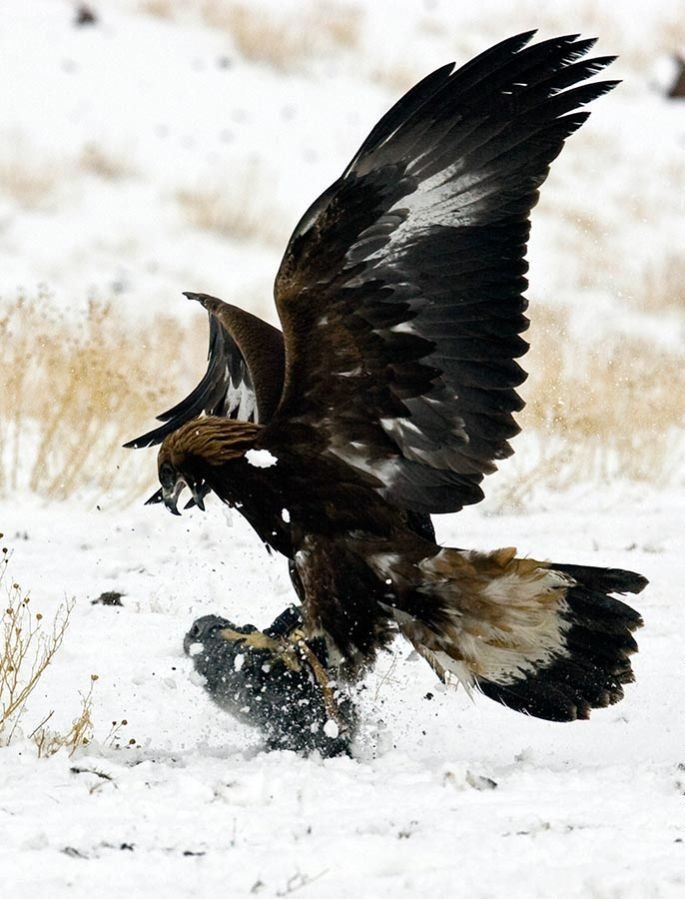Hunting Rabbits With Golden Eagles, Kazakhstan
|
• North America
In North America the situation is not as dramatic. It appears the greatest density of Golden Eagles anywhere in the world occurs in the Western United States and Western Canada. In total, the contiguous Western United States may hold up to 30,000 individual Golden Eagles, with a total of 70,000 to 100,000 individuals estimated across all of North America. One estimate of the number of breeding pairs in the contiguous Western United States that excluded California, South Dakota, Montana and Oregon was 9,387. The state with the largest known winter count of Golden Eagles is Montana with 13,138, followed by Wyoming with 10,072, Colorado with 7,081 and Utah with 5,993. Wyoming had the highest estimated set of breeding pairs 3,381-4,174, followed by 1,800 in Utah, 1,200 in Nevada and California and Idaho both with around 500 pairs (notably, Montana was not included in these particular studies, although the breeding population must include well over a thousand pair there). In 6 out of 8 Canadian providences where Golden Eagles breed, over 10,000 birds were observed in breeding bird surveys. In 1981, it was estimated that there were 63,242 wintering individual Golden Eagles in the 16 Western United States (excluding Alaska). However, there has still been a noticeable decline in some areas.
• Threats
In modern times, almost all threats to Golden Eagles are attributable, directly or indirectly, to human activities. In fact, all Aquila eagles in Eurasia face the same human-sourced threats as the Golden Eagle: habitat change, persecution, poisoning (often directed at other species) and collisions with man-made objects. Certainly the most widespread unintentional threat to Golden Eagles by humans is urbanization and human-population growth which have made areas historically used by eagles unsuitable both in terms of habitat and prey availability. Habitat destruction in North American had, by the late 19th century, already driven Golden Eagles from some regions they used to inhabit. In Southern California and the Colorado Front Range, this has been proved via long-term population and habitat surveys. In Western China, the main threats to Golden Eagles are land development, the use of pesticides and apparent regular captures for falconry. Fires since 1980 have caused large-scale losses of shrubs and jackrabbit habitat in areas used by eagles throughout the Intermountain West of North America. Wildfires that burned more 40,000 hectares of scrublands between 1981 and 1987 in the Morley Nelson Snake River Birds of Prey National Conservation Area affected nesting populations adversely. Nesting success at burned territories in Snake River Canyon declined after major fires. Abandoned burned territories have been subsumed by neighboring pairs, resulting in a decreased number of nesting pairs. In a few cases, mankind has accidentally benefited Golden Eagles by logging previously heavily wooded areas. This has been recorded in the 1800s and 1900s in the Appalachian Mountains of the Eastern United States, where reforestation has now made the habitat unsuitable for nesting eagles, and in Washington state, which still holds breeding eagles in desolate areas that have been logged. Afforestation, the commercial planting of non-native woodland, is a serious issue in Scotland, with the largest amount of it occurring in southwestern Scotland, especially in Argyll. During afforestation, the land is ploughed and in excess of 2,500 seedlings are planted per hectare, mainly with exotic conifers including Sitka spruce (Picea sitchensis) and lodgepole pine (Pinus contorta). The woodland canopy closes and ground vegetation dies, making these dark and gloomy places until harvesting in 40 to 50 years. More than 50% of land in Scotland at an elevation of 200–600 m (660–2,000 ft) has been planted as such. Afforestation requires removal of sheep and the fencing out or shooting deer, both important sources of carrion for Golden Eagles. Foraging areas of Golden Eagles have been confirmed to not include afforested areas.
|
|









